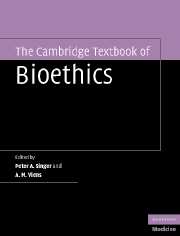Book contents
- Frontmatter
- Contents
- List of contributors
- Acknowledgements
- 1 Introduction
- Section I Information problems
- Section II End of life care
- Section III Pregnant women and children
- Section IV Genetics and biotechnology
- Section V Research ethics
- Introduction
- 25 Research ethics
- 26 Innovation in medical care: examples from surgery
- 27 Clinical trials
- 28 Epidemiological research
- 29 Clinical research and the physician–patient relationship: the dual roles of physician and researcher
- 30 Financial conflict of interest in medical research
- 31 Embryo and fetal research
- Section VI Health systems and institutions
- Section VII Using clinical ethics to make an impact in healthcare
- Section VIII Global health ethics
- Section IX Religious and cultural perspectives in bioethics
- Section X Specialty bioethics
- Index
- References
31 - Embryo and fetal research
Published online by Cambridge University Press: 30 October 2009
- Frontmatter
- Contents
- List of contributors
- Acknowledgements
- 1 Introduction
- Section I Information problems
- Section II End of life care
- Section III Pregnant women and children
- Section IV Genetics and biotechnology
- Section V Research ethics
- Introduction
- 25 Research ethics
- 26 Innovation in medical care: examples from surgery
- 27 Clinical trials
- 28 Epidemiological research
- 29 Clinical research and the physician–patient relationship: the dual roles of physician and researcher
- 30 Financial conflict of interest in medical research
- 31 Embryo and fetal research
- Section VI Health systems and institutions
- Section VII Using clinical ethics to make an impact in healthcare
- Section VIII Global health ethics
- Section IX Religious and cultural perspectives in bioethics
- Section X Specialty bioethics
- Index
- References
Summary
The year is 2016. J and K meet with their pediatrician to discuss whether their 11-year-old daughter, L, should undergo a newly available course of stem cell therapy to cure her type 1 juvenile diabetes. Left untreated, L's illness could lead to blindness, life-threatening circulation problems in her extremities, and, perhaps, early death. The therapy that L's parents and her pediatrician are contemplating requires careful HLA (immunological compatibility) matching with one of the thousands of human embryonic stem cell (hESC) lines identified in an international registry. These were created over the previous decade from frozen human embryos remaining from infertility procedures and were donated to research or therapy by their progenitors. A matching population of specially created pancreatic stem cells could be made from one of these lines and infused into L to remedy her insulin deficit. While many parents would leap at this life-saving opportunity, J and K – and their physician – face a moral quandary. They are all devout Roman Catholics and share their church's view that human life must be regarded as sacred from the moment of conception. They view the destruction of a human embryo for stem cell research or therapy as equivalent to killing a human being. The physician explains to J and K that the frozen human embryos used to create hESC lines were slated for destruction. Is it not better, he asks, that such embryos at least be used to save lives? But J and K are also aware of their church's moral teaching that “one should not do evil in order that good may result.”
- Type
- Chapter
- Information
- The Cambridge Textbook of Bioethics , pp. 231 - 238Publisher: Cambridge University PressPrint publication year: 2008
References
- 2
- Cited by



